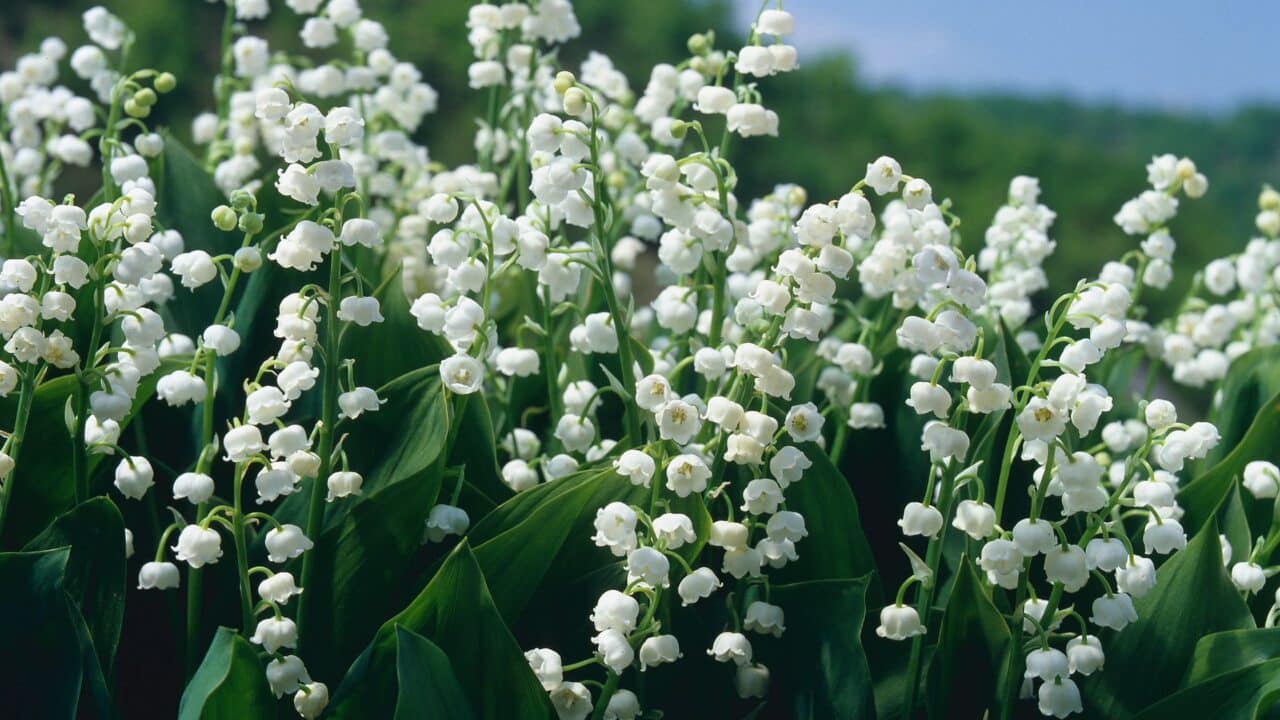The Complete Guide to Lily of the Valley
A fragrant groundcover that thrives in shady, difficult spaces
🌱 Quick Overview
-
Botanical name: Convallaria majalis
-
Common name: Lily of the Valley
-
Type: Perennial groundcover
-
Zones: USDA 3–8
-
Light needs: Part to full shade
-
Soil: Rich, moist, well-draining, slightly acidic
-
Growth habit: Spreading via underground rhizomes
-
Mature height: 6–10 inches
-
Toxicity: All parts are toxic to pets and humans if ingested
Life Cycle of Lily of the Valley
Lily of the Valley is a cold-hardy, perennial groundcover with a strong seasonal rhythm:
-
Early Spring: Shoots emerge from underground rhizomes as soon as the soil warms. Flower stalks appear shortly after.
-
Mid to Late Spring: Small, white, bell-shaped flowers bloom in clusters — highly fragrant and a highlight of the plant’s life cycle.
-
Summer: Flowers fade, and lush green leaves remain, forming a dense carpet.
-
Fall: Foliage gradually yellows and dies back. Some plants may produce small red berries (not edible).
-
Winter: Dormant underground; invisible above ground but alive and ready to return.
Lily of the Valley spreads steadily but not aggressively, forming colonies over time.
When to Plant Lily of the Valley
The best time to plant Lily of the Valley is in fall or early spring:
-
Fall (Sept–Nov): Plant dormant “pips” (rhizomes) about 1–2 inches deep.
-
Spring (Mar–May): You can also transplant actively growing plants if soil is workable and frost has passed.
Planting in cooler seasons helps roots establish before summer heat or winter cold.
How to Plant Lily of the Valley
-
Choose a shady spot — under trees, along fences, or on the north side of buildings.
-
Prep the soil by loosening 6–8 inches deep and mixing in compost or leaf mold.
-
Space pips 4–6 inches apart, pointed tip up, and cover with soil.
-
Water well after planting and keep the area evenly moist through establishment.
Lily of the Valley prefers moist but not soggy soil. Mulching can help retain moisture.
Maintenance Tips
Lily of the Valley is low-maintenance once established, but keeping it healthy means occasional attention:
Watering:
-
Requires consistent moisture, especially in its first season and during dry periods.
-
Can tolerate dry shade once mature, but prefers regular watering.
Mulching:
-
A thin layer of leaf mold or shredded bark mimics its natural forest floor habitat.
-
Avoid piling mulch against crowns.
Pruning:
-
Remove dead foliage in late fall or early spring.
-
You can mow or cut back the patch once it has gone fully dormant.
Fertilizing:
-
Not usually necessary in healthy soil.
-
If desired, apply a light compost top-dress in spring.
Pest & Disease:
-
Rarely bothered by pests.
-
May develop leaf spot or rot in overly wet, poorly drained areas.
Wildlife & Ecology
Lily of the Valley offers limited ecological benefits, but it’s valued for its scent and low-maintenance habit:
-
Pollinators: Some bees and moths visit the flowers, but it is not a major nectar source.
-
Toxicity warning: The entire plant contains cardiac glycosides — toxic to pets, children, and livestock if ingested. Avoid planting near play areas or animal pens.
-
Deer and rabbits: Typically avoid it due to its toxicity.
-
Ground cover habitat: Provides cover for small beneficial insects and helps reduce erosion in shaded areas.
Best Uses in Landscaping
Lily of the Valley shines in dense shade and areas where other plants fail. It’s especially well-suited to:
-
Under mature trees (like spruce, maple, or pine)
-
Woodland gardens
-
Shaded foundation beds
-
Narrow side yards
-
Naturalized shade borders
It spreads slowly but forms a beautiful, fragrant carpet. Just be aware: it can be invasive in some regions, so check local guidelines and plant within defined areas.
Companion Plants
Lily of the Valley pairs beautifully with other shade-tolerant, non-competitive perennials, including:
-
Ferns – add vertical texture and blend well with woodland themes
-
Hostas – mix well for a contrast of leaf shapes
-
Brunnera – for small blue flowers in early spring
-
Heuchera (Coral Bells) – adds rich color variety in foliage
Avoid planting next to delicate groundcovers that can’t compete with its rhizome spread.
Final Thoughts
If you’re looking for a fragrant, low-maintenance groundcover for deep shade, Lily of the Valley is hard to beat. Its spring flowers bring seasonal charm, and its foliage provides lasting ground coverage throughout the growing season. Just give it a moist, shady place to spread—and enjoy the transformation of a once-bare space into a lush, green carpet.
Whether you’re working under evergreens or trying to fill a tricky north-facing slope, Lily of the Valley is a reliable, beautiful solution — just remember to plant it where pets and kids can’t nibble.

